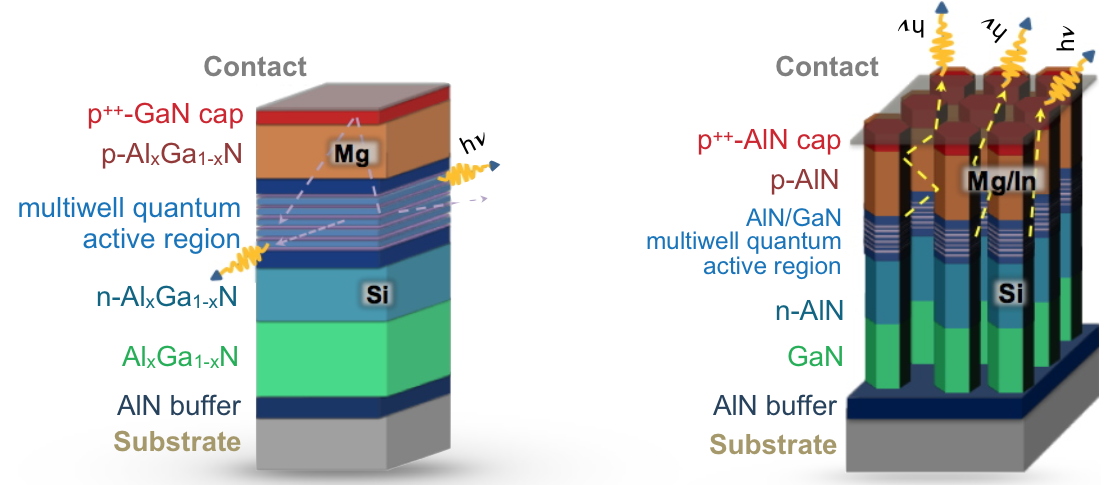The international Minamata Convention, which came into effect August 16, 2017, aims at eventually banning the use of mercury and mercury-based devices, due to the high toxicity of this element for the nervous system. This concerns mercury lamps which are the traditional sources of UV light for a wide range of applications including water and air treatment, disinfection, psoriasis bleaching, banknote counterfeiting detection, agriculture etc... This context favourably affects the fast-growing market of light-emitting diodes (LEDs) in the UV range and strongly stimulates research and development in this field. The recent emergence of Covid-19 and the likelihood of other highly pathogenic viruses emerging in the future make it particularly urgent to find effective and easy-to-use "mercury-free" solutions for surface disinfection by UV-C irradiation.
UV LEDs are made from nitrides of element III (third column of the Periodic Table of the Elements),
i.e. GaN, AlN and their alloy AlGaN. With the progressive ban of mercury, there is a growing, worldwide interest in this type of LED, illustrated by the rapidly increasing number of players in the field. However, the
external quantum efficiency of most UV LEDs produced remains low. A very small number of players were able to demonstrate an efficiency of more than 10%, but most devices in the UV-C range used for sanitary applications (230-280 nm) exhibit an efficiency of less than 5%. The main causes of this reduction in efficiency for increasingly shorter wavelengths (achieved by increasing the molar fraction of AlN in the AlGaN alloy) are assigned to the presence of crystal defects such as "dislocations" and the associated non-radiative recombination,
i.e. optical "losses", if the density of the dislocations exceeds 10
8/cm
2. This limitation is also related to light extraction limits and to the difficulties of
p-type doping for an increasing molar fraction of AlN, which increase the electrical resistance and make the electrical contacting of the LED more and more difficult to achieve.
In this context, researchers from the IRIG and the Néel Institute recently obtained a spectacular result by demonstrating that the incorporation of a small fraction of indium in AlN together with magnesium (which is the doping material) led to a considerable increase in the quantity of magnesium incorporated and therefore in the level of p-type doping of the AlN nanowires used. The use of nanowires, rather than thin films, also facilitates the relaxation of the stresses generated by the dopant. This result is a significant break with the state of the art. It was confirmed by the realization of a p-n junction with AlN nanowires and paves the way for the realization of a new type of UV-C LED whose process has been patented. It also opens the way to the realization of hybrid LEDs for UV-C, an approach also patented by the researchers.

On the left, structure of a "standard" LED. On the right, structure of a nanowire LED (patented) taking advantage of the p-type doping achieved for AlN nanowires.
The
external quantum efficiency is the ratio of the number of photons extracted from a LED to the number of charges injected.
Doping is the addition of impurities in small amounts to a semiconductor to modify its conductivity properties. There are two types of doping. n-type doping consists of increasing the electron density. p-type doping, on the other hand, reduces the electron density and creates missing electrons or "holes", which behave like positively charged particles.